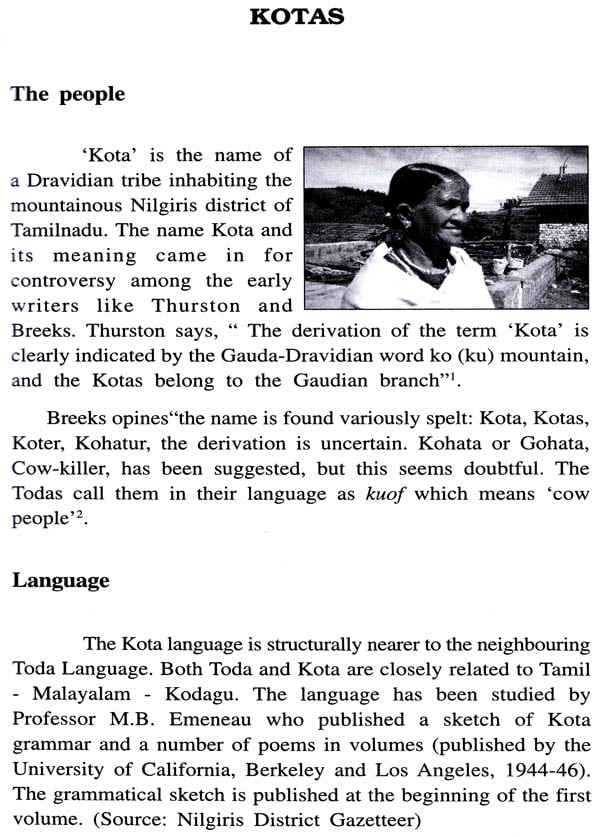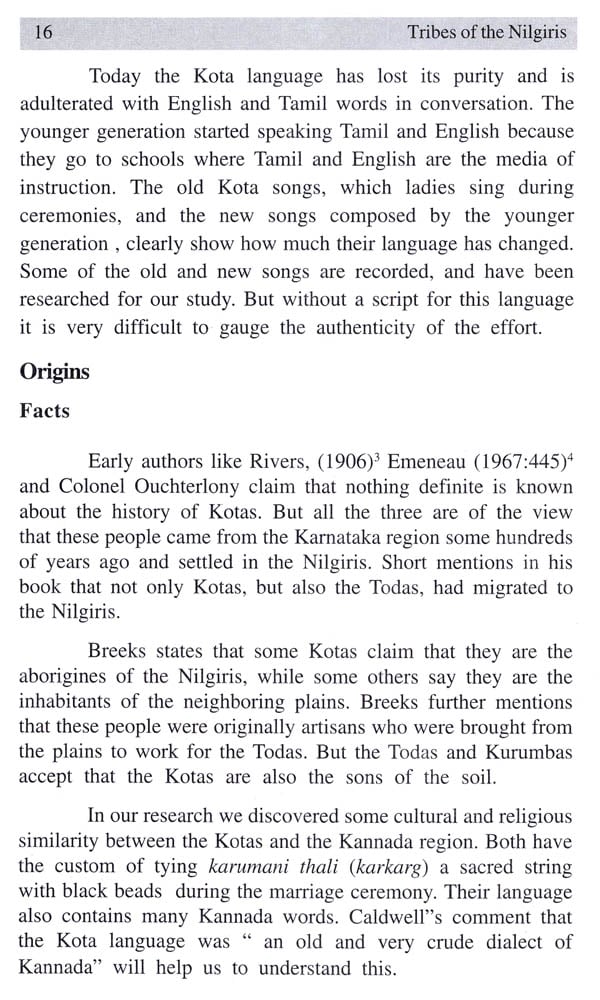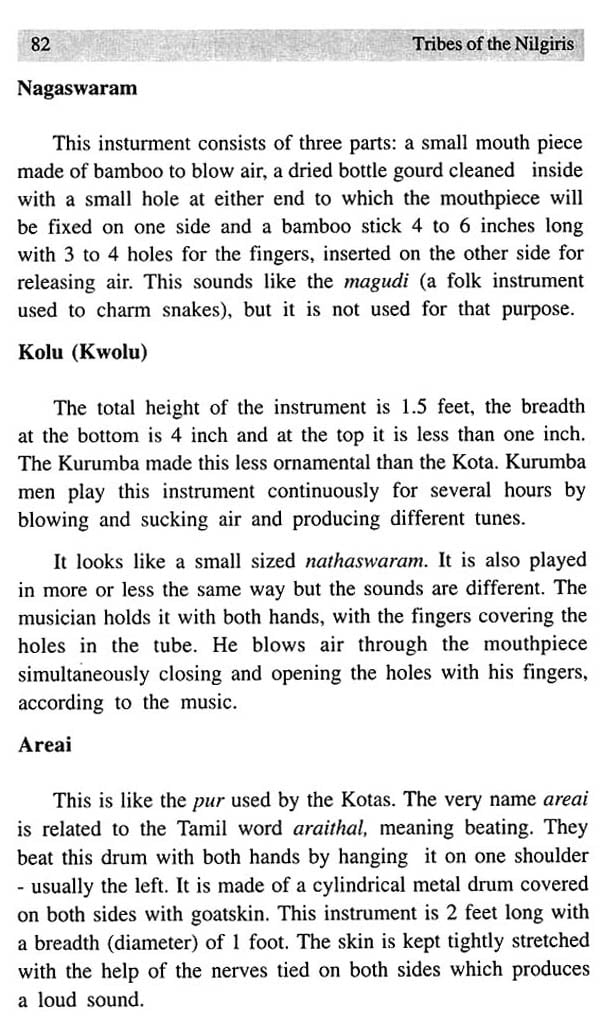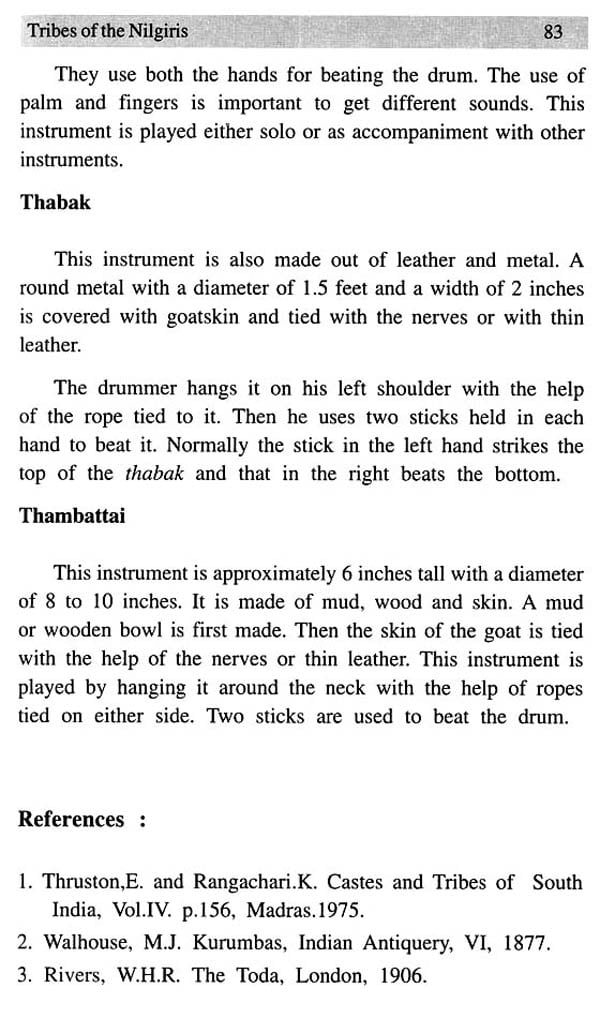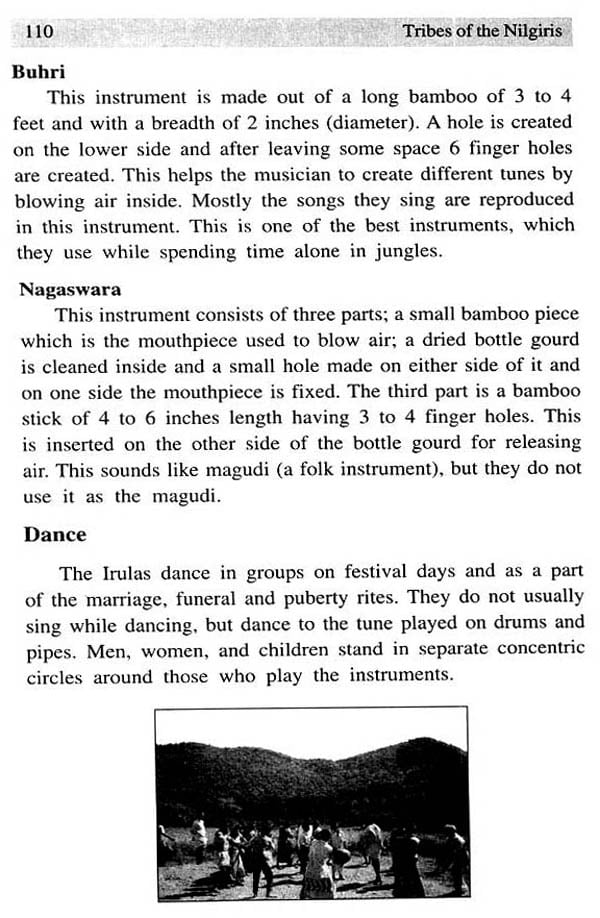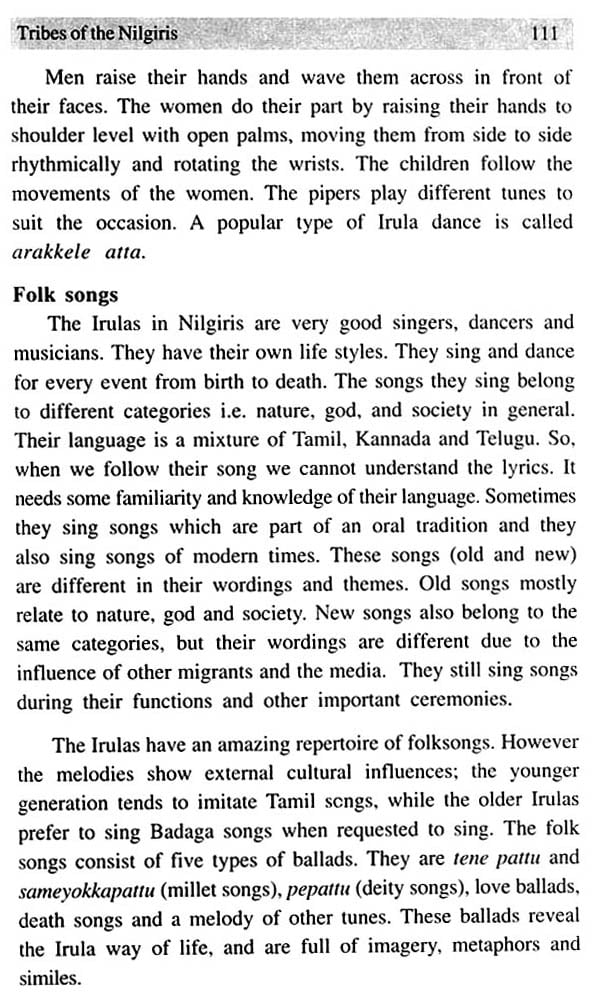
Tribes of The Nilgiris (Arts and Crafts of the Kotas, Krubas, Irulas and Paniyas)
Book Specification
| Item Code: | NAU044 |
| Author: | G. Balaji |
| Publisher: | The C. P. Ramaswami Aiyar Foundation, Chennai |
| Language: | English |
| Edition: | 2007 |
| ISBN: | 9788190148443 |
| Pages: | 139 (48 Color 46 B/W Illustrations) |
| Cover: | PAPERBACK |
| Other Details | 8.50 X 5.50 inch |
| Weight | 230 gm |
Book Description
Since 1981, the C.P. Ramaswami Aiyar Foundation has been working in the Nilgiri hills to protect the environment and uplift the tribes who are an essential part of the environment.
In the course of this work, it became apparent that the tribes were being marginalized and were in danger of losing their identity and culture. The relentless advance of "civilization" has been replacing the symbols of their culture. There is the danger of their permanent loss.
Each tribe of the Nilgiris had a particular role and occupation that could not be shared by others. The Todas were on the top of the hierarchy and were herders of buffalo, providing milk. Kotas were potters, working with the earth. Kurumbas were medicine men, with knowledge of herbal medicines and dispersal of spirits. Irulas were musicians and Paniyas bamboo workers. The strict separation of occupations and taboos prevented one tribe from performing the occupation of another, and is suggestive of a possible origin of the caste system itself, which was based on varna or occupation.
The items made by each tribe were exchanged with those made by the others in the barter economy that existed among the hill tribes. Styles and designs of artefacts were developed to suit their use. Decoration was generally ritualistic, developed to express their hopes and fears, happiness and sorrow.
Among the Kurumbas was an elderly man, the last painter of the tribe, who alone knew the art handed down by his Kurumba ancestors who, the tribe believe, were the authors of the three thousand year old rock paintings at Eluthu Paarai . He was persuaded to teach his son Kitna, after which the Foundation formulated a project by which the son taught another ten of his tribesmen the ancestral ritual. Today the traditional Kurumba ritual of painting has been saved, and has become a source of generating income for the Kurumbas .
Kurumba painting is similar to other tribal painting, yet unique. It replicates the scenes of forest life, subsistence agriculture and animal herding. But the location of the tribe in the forests of the Nilgiris has given them a unique insight, which has translated itself into a variety of plants with varied leaves, wildlife and forest-related activities such as honey collection.
Similarly, there was only one extant wood carver among the Kotas , the elderly Krishnan.. Before the pottery tradition also disappeared, the Foundation arranged for twenty Kota women to learn the traditional method of pottery, and adapt it for contemporary use. Later, this too was adapted for the market.
With the fast disappearance of tribal arts and crafts, it was decided to survey and document the art and craft traditions of four tribes — Kurumba, Kota, hula and Paniya. The Todas were deliberately excluded as there have been several studies and documentation of their lives, culture and traditions. Far less is known of the other four tribes. Very little can be seen in the hills today: the Foundation has possibly the last anthropological collection.
G. Balaji spent two years living and working among the tribes to learn about their art and craft traditions. Apart from this book, the music and dance traditions have been audio and video taped respectively, and will be a permanent record of these four ancient tribes and their culture. His painstaking effort is highly commendable and the result is this excellent compilation.
India's tribes have survived millennia, yet the population and civilizational onslaught of the last century is finally defeating them. This is a great pity. These proud and noble people chose a remote home that they may live undisturbed. Modern India has been insensitive to their needs. Development need not bypass them. But they must be given the choice to develop and adopt contemporary lifestyles. Instead, development is rolling over them like a bulldozer. This book is a tribute to four ancient and unique tribes who have lived undisturbed in the oldest human settlements of South India. This publication is the Foundation's tribute to a great people and a great tradition. Along with the CD of their folk music and dance, the records of their art and craft traditions is a part of our indispensable knowledge bank. This goes to affirm the mosaic of diverse traditions that form the great Indian sub-continent.
The Nilgiris district has been designated as a tribal district as it shelters ten different tribal groups: the Todas,Irulas, Kotas, Paniyas, Kasabas, Sholigas, Betta Kurumbas / Urali Kurumbas, Mullu Kurumbas, Jenu Kurumbas, Halu Kurumbas / Alu Kurumbas and Kattunaikas.
Tribal art is generally ritualistic, blurring the distinction between the artist and the art lover. It is enmeshed within the consciousness of the whole tribal society and consequently, it changes according to the developments within the society. However, tribal art forms remain fixed to a single aesthetic dimension and do not allow extreme variants.
Tribal people are generally very artistic by temperament, and poverty does not limit their talent. In the Nilgiris, the daily activities of the tribes bring out their tribal arts and crafts in various dimensions and manifestations.
The artistic creations of the tribes of the Nilgiris include
* Stories, songs and dances.
* Arts such as carving and painting.
* Crafts like weaving, bamboo work, cane work and embroidery, among others.
While every tribe has a specialization and a unique character girvey and documentation is limited to four tribes of the s. They are the Paniyas, Kotas, Irulas and Kurumbas.
Each tribe has a specific role to play in the hill area, leading specialization. For example, the Kotas make pottery, iron carpentry, and musical instruments, Irulas and Paniyas create instrumental music, and Kurumbas are musicians, craftsmen and artists.
The discovery of Ooty by the British has endowed us with a wonderful summer resort. But the tribal inhabitants are the sons of the soil and they have suffered a lot due to the loss of their isolated peaceful lives. They have lost their homes, identity, culture, and uniqueness.
This documentation deals chapter-wise with the four tribal communities viz. Kotas, Kurumbas, Paniyas, and hulas. The survey and documentation have been carried out separately for each tribal community. The important aspects dealt with are the stories of their origin, descriptions of their settlements, the village set-up, the construction of houses, their languages and their similarity to other regional languages, the occupations in which they have traditionally specialized, their arts and crafts.
Each tribe has an effective and well-organized town planning system, with a unique way of constructing houses, cooking vessels and food habits. Each tribal community has different occupational groups. For example, among the Kotas there are potters, blacksmiths, carpenters, etc., who practice their traditional craft methods. They have faith in God. They believe in deity worship and practise animal sacrifice.
The physical appearance, dress and ornaments, household activities, etc. are also explained. Several of their ceremonies from birth to death are also completely documented. Agni (fire) plays an important role during festive occasions as well as in various other ceremonies. Each tribal group has a different system of marriage.
In particular, the art and crafts of these four tribes of the Nilgiris have been documented to preserve their traditional knowledge and skills for future generations. Kotas are artisans skilled in blacksmithy , carpentry, pottery, and agriculture; Kurumbas are ignorant about pottery making, but are talented in collecting jungle products and in traditional painting.
The bamboo crafts of these tribes are now slowly disappearing because of the restrictions imposed by the forest department on collecting bamboo from the forest, and the craftsmen who know this art are passing away without teaching it to the younger generation. Paniya, hula and Kurumba are very talented in bamboo crafts, like making fishing baskets, bows and arrows, baskets, doors, cattle sheds ,birds' nests, etc. The documentation of these crafts show that these are now in the dying stages.
In the Nilgiris, the Kotas, Irulas, Kurumbas and Paniyas play instrumental music. However, their musical instruments vary considerably. Kota men are expert musicians and are employed by the neighboring Toda tribes. Irulas, with their kwalu ( a dwarf pipe), perform instrumental music for hours together. They use a peculiar long flute known as the buhiri. Nagasore is yet another wind instrument of the hulas which resembles the snake charmer's flute. The Paniya tribes play instrumental music only during festive occasions. Cheemam or ceeno, a musical horn, and thudi, a percussion instrument, are their musical instruments of note.
Tribal songs describe the extraordinary events relating to their social order, economic pursuit, arts and crafts, religious beliefs and ceremonies.
Tribal people participate spontaneously in dances. The basic qualities are the vigorous rhytm and abandon, expression of and the zest for life. Dancing in a circle is the basic formation of most tribal dances. During evenings in a tribal e, one may come across groups of young tribal men and dancing to the accompaniment of the drum at a high pitch.
The occasions for indulging in dance may be a full moon, a wedding, a good harvest or for no particular reason! Their dances are vigorous, colourful, and stimulating — an amazing melody of music, rhythm and folklore. They are not mere entertainment for the tribal folk; they are part of their way of life, as important as food or work. In them are reflected their struggle for existence, their attitude to nature, and their child—like sense of wonder at seeing the changing symbols.
Almost all tribal groups perform dances chiefly during their religious ceremonies and, occasionally, as a pastime. Dance performances among the various tribal groups vary from one another, although they may have been mutually influential in the past. The most distinctive aspect is the repetition of a movement, song or tune. The form is constant, in spite of the inclusion of new ballads.
The tribal people believe that their sacred dances were taught by their gods, thus showing the sacred origin of the dance. Living close to nature and entirely dependent on her for sustenance, they believe in the worship of spirits and supernatural powers.
**Contents and Sample Pages**

